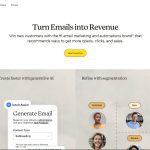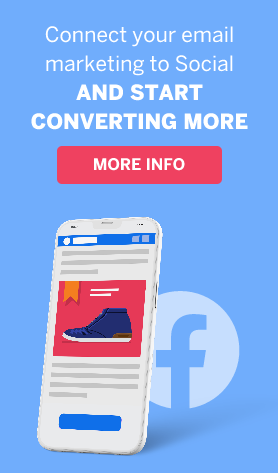Top 7 Best Email Marketing Software Solutions
If your 2024 business strategy includes email marketing, you’re probably using an email marketing software or in the hunt for the best one in the market to suit your needs.
From its inception, email marketing has been the #1 digital communication channel. It’s not just a tool to connect with your audience; it’s a great tool to build long term engaging relationships and convert your email subscribers to paying customers, over and over again.
Choosing an email marketing platform can be daunting. But you shouldn’t feel overwhelmed. Remember, the work is not done by just choosing the perfect email marketing software, what you do with its varied features and the sort of use you get out of it is entirely up to you and your ability to create a long-lasting strategy compiled of compelling messaging, a proper customer journey and the correct automated email workflows.
In this article, we separate the wheat from the chaff for you, by assembling a list of our top email marketing software picks and provide all the information you need to know before picking the right software for your brand needs.
How to choose an email marketing software?
Remember these three strategies when choosing an email marketing software:
-
Stay Brand Authentic And Customer-Centric
There is almost no limit to the number of things you can do with a proper email marketing software and its features. With that being said, many companies don’t take full advantage of all it has to offer. That’s where marketing automation comes in the picture.
When creating an automated email workflow, it’s crucial to consider your subscribers and potentially, customers point of view. Each stage should cater to their needs and accommodate each part of the customer journey. Only then your workflow can reach its ultimate goal – a higher conversion rate.
A customer-centric approach has to be part of every email marketing strategy, and it should be coupled with other emails to build brand authenticity.
-
Deliverability Is About Quality, Not Quantity
Deliverability is a key concern for marketers as poor data management, and increased standards can lead to your emails landing in the SPAM folder.
Simply put, deliverability is the ability to deliver emails without interference. When searching for the right email marketing plaftorm, it’s important to pay special attention to authentication processes available like using double opt-in in the sign-up forms and much more.
-
Personalization is Key in the Email Marketing Realm
Personalization always wins in the email marketing realm. When creating a strategy for your email marketing workflows, use as many personalization features as possible. Be sure your email marketing software gives you as many personalization options as a software can (Birthday or anniversary emails, first name headlines, segmentation, the ability to predict the best time to send each email by previous data analysis, behavioral triggers and more).
3 Must-Have Features Of Email Marketing Software
Once you embark on a journey towards finding the best email marketing software, you should create a checklist of must-have features. Pay particular attention to your brand needs, research your industry and learn about all the latest innovations.
Here are our top three picks for must-have features in an email marketing platform:
Integrations
Email marketing brings in a lot of crucial data for the marketing team;
Identifies the customer journey;
Understands the customer requirement based on their interactions and behavior online;
Curates content that suits the customers perfectly;
Brings in a steady stream of marketing qualified leads;
Provides feedback about the product quality to the operations team.
When selecting an email marketing software, you will have to make sure that it is efficient in extracting data from the existing tools that you use such as Customer Data Platform (CDP), Customer Relationship Management (CRM), a Content Management System (CMS), etc.
Additionally, integration capabilities can also help with task management. For example, integrating your email marketing software to your CRM is a must for proper lead nurturing.
Email Marketing Automation
While newsletters and blast campaigns are both a part of email marketing strategies, automatic email campaigns are often the smartest choice. Unlike newsletters and blast campaigns, automated email campaigns are created and automatically sent to each particular user based on behavior or other predetermined triggers. Email marketing automation helps in;
Increasing product usage;
Gathering product feedback;
Informing customers of important updates;
Offering personalized messages on special occasions;
Nurturing leads;
And, promoting your new blog posts.
Usability And Support
These are two essential features that every email marketing software ought to have – an easy to use software, and continuous support. The ease in using software is what makes it a delight for the users. The software that you choose must be;
User-friendly;
cost-efficient;
Valuable in terms of productivity;
Easy to set-up.
Furthermore, email marketing software solutions being a complex system would require continuous support from the vendor. A short downtime can even lead to substantial losses. Thus, an email marketing platform provider should have a dedicated support team via chat, email or phone.
Digital marketers have a lot of options these days when choosing an efficient email marketing platform. Nevertheless, the best email marketing software for a particular business mainly depends on factors such as budget, requirements, and data capabilities.
Before we proceed further into breaking down the importance and factors to consider when choosing an email marketing software, let’s take a close look at our choices for the best email marketing platform in the market in addition to ActiveTrail.
Our Picks for the Top Email Marketing Software in 2024
1. ActiveTrail
ActiveTrail is the only email marketing tool out there that addresses all the downsides left behind by the other email marketing software solutions mentioned in this list. Let it be the annual pricing structure, technical glitches, or the complexity of the software solution, ActiveTrail makes sure it overcomes all the challenges to evolve as the best email marketing software solution for small to large businesses.
With easy and visual automation, ActiveTrail integrates with not just one or two but hundreds of apps, and e-commerce stores.
Furthermore, the main positive features of ActiveTrail include RESTful API, a multilingual operating system, prompt support via chat, phone, and email, and a varied education centre alongside SMS marketing and superb affiliate programs.
Lastly, to make things all the more interesting, ActiveTrail offer affiliate marketing services where the partner could earn around 15% renewable monthly commission. Almost anyone can become a partner and start earning.
Pricing:
Though they don’t currently offer a free payment package which does not require a payment method in advanced, there is a wide array of payment plans with attractive pricing that you could choose from. The monthly plan starts at $8 for up to 500 contacts, which can further be extended to 10,000 contacts at $55/ month.
Bottom line –
ActiveTrail is an excellent value choice with all the advanced features necessary and without the hassle of implementation and expensive payment plans. Sign up for a free trial, especially if you’re a start-up, run a B2B business, an online shop or have an SMB.
2. HubSpot
Hubspot is an all-in-one suite for inbound marketers and marketing teams. With powerful features that help businesses grow, HubSpot offers a CRM platform, has a social media management feature that is very intuitive and easy to use, and great sales functionalities. Hubspot also has a very advanced learning center with great content and training programs for marketing skill-building.
Its wide variety of features requires a training course even before a user dives into the platform. Additionally, it doesn’t offer a/b testing unless your a pro-user and that is a must-have in the email marketing department. And while some users can afford the pro-enterprise payment plan, unfortunately, most small-medium businesses might be affected by it.
Pricing:
The basic payment plan starts at $50/month but when adding additional features, it can reach as high as $2,000/month.
The payment has to be made annually which might be a bit difficult for SMB’s.
Bottom line –
HubSpot is great if you are a startup, your target market is in the US and your team has a high marketing budget to spend
3. Constant Contact
Constant Contact is pretty easy to navigate through and use even if you are a beginner. It’s simple to manage your email lists, marketing calendar, contacts, email templates and more as each account provides you with access to easy tracking and reporting, free image library, built-in social media sharing tools, Facebook ads integration and eCommerce integration for Shopify stores.
Constant Contact offers a 30-day trial which helps try out the software before making a decision, but it does not include advanced features such as surveys, subject line A/B testing (a 100% must in email marketing) and more.
Pricing:
The basic payment plan starts at $20/month and goes up to $45/month for all features. Unfortunately, there is no annual plan. And even though the first month is free, customers still have to use a credit card to open an account and remember to delete it, should they choose not to continue with the plan.
Bottom line –
Use Constant Contact if you’re mostly interested in blast email campaigns.
4. MailJet
MailJet includes crucial services for developers, enterprise-grade teams, and marketers. MailJet nails it when it comes to sending personalized and optimized business class or transactional emails which help with sales.
MailJet also provides users with a unique IP address so that they stay in full control of their sender reputation, though it has its benefits, it might be an issue if the marketing team is not clear about feature management and might lead to deliverability issues.
Pricing:
The basic payment plan is free but does offer very limited features.
Plans are limited to the number of contacts and emails sent per month and in order to unlock all advanced features (email automation, testing, and API), a user can pay up to 369$/month.
Bottom line –
Try MailJet if you mostly care for transactional messages when it comes to email marketing.
5. SendGrid
SendGrid is your simple and easy to use an email marketing software. It offers users pre-designed email templates, a landing page builder and an email statistics tool which will help improve the open and click-through rates for email marketing campaigns.
Its marketing automation feature is still in BETA but users can already create simple automated workflow emails. It also offers expert insights services like email trends, sender reputation status and reports which will help the users improve their email marketing results.
Pricing:
The basic payment plan is actually free but all it offers is simple email blasts. To enjoy the full feature range, SendGrid offers a pro user plan which costs $79.95/month and can go up to $699/month, depending on the number of contacts.
Bottom line –
SendGrid is great for transactional emails and email blasts. Its advanced features are still in BETA so if you’re counting on automating your emails, this will not be the best solution for you.
6. MailChimp
MailChimp is a great straightforward email marketing platform. One of the most popular software in the market, MailChimp offers useful features with a focus on converting visitors to customers. MailChimps services are affordable with many third-party integrations, and helpful documentation.
It is great for small businesses and bloggers/content creators that are just getting started with email marketing but does not include a multilingual software, support team or learning center, limiting to English speaking users only.
Pricing:
MailChimp offers a free plan with the option to email up to 2,000 contacts and send over 12,000 emails per month but it does not offer advanced features or customer support to free payment plan users. Advanced price plan begins at 199$ per month and depending on the needs, users can pay up to 625$ per month
Bottom line –
MailChimp works well for bloggers, new businesses and SMB’s cause they are most interested in simple email delivery and don’t require phone support.
7. AWeber
Aweber is one of the oldest and most popular email marketing software solutions in the market and has a wide variety of helpful tools for small and medium businesses.
AWeber offers easy integrations with major platforms such as WordPress, landing page builder, opt-in form builder, etc. AWeber provides a library of email and newsletter templates, has an autoresponder feature and allows each user to track emails and manage contact lists with ease.
Pricing:
Aweber offers a free 30-day trial, and the basic payment plan begins at $19/month, but it’s limited to 500 contacts only. If a user’s contact list grows, he has to increase his monthly payment plan and might pay up to $129/month or more.
Bottom line –
Sign up to Aweber if you have a small contact list and are not expecting a fast paced business growth since the payment differences are quite high.
The Importance Of Email Marketing
Email marketing has the highest ROI out of all other digital marketing channels, at $44 income per every $1 spent, not using it as a marketing tool is making a big mistake.
In the B2B industry, over 86% of marketers choose email marketing as their preferred marketing channel.
Due to innovation in the technological arena, email marketing has transformed from a simple messaging tool into a powerful automated machine. Advanced targeting strategies, segmentation, personalization and creating customer journeys are just the tip of the iceberg when it comes to what email marketing software has to offer.
Here are a few more reasons you should consider email marketing as your top pick for a marketing channel:
They Are Customizable
When a new contact signs up to your list, he’s basically saying “tell me more, I’m interested in your product, brand, company”. Maintaining this interest for a long time requires a skill set every marketer wishes to have, it starts with customizing personal messaging as if each contact is special. Using a great email marketing software will give you this advantage with a wide variety of features (dynamic content blocks, A/B testing, segmentation and more).
They Are Personal
Unlike social media advertising and PPC, you reach a specific audience who already have expressed their interest in your services or products through email marketing. Now it’s easier than ever to create a long lasting relationship with your contacts.
They Are Widely Used
Most businesses and companies carry out their communication by email and it is expected from brands to maintain a newsletter communication with the customers.
To sum up, picking the right email marketing software is not easy, the market is saturated, advanced features pop up every minute and there are many factors to consider.
When making your research you should answer these simple questions to guide you through:
- What is your business size? Small, medium or enterprise? This should be very clear since the answer will impact your ultimate experience with each software.
- How many contacts do you have and what is the growth prediction? Are you expecting to grow over the next few months? Years? By what percentage? If you’re starting from scratch, you will probably have completely different business and marketing needs from those who already have a contact list with subscribers and accumulated data.
- How many people will be using the software? Is it just you, the business owner or is it the entire marketing team? If more than one user is required per platform, make sure it’s an included feature.
- What do you want to do with email marketing software? Sure, the simple answer would be “send emails with marketing materials” but in today’s climate, there is so much more you can do when you find the right software for you. Map out all the possible features email marketing software have to offer, from the simplest ‘contact list management’ to advanced ‘RESTful API’ and CRM integrations, automated workflows and lead management. Once you map out all features, create a list of at least 10 must-haves, this way you will be able to easily track them when researching a platform.
- What’s your budget? Generally, there is a very average price range for the different email marketing platforms in the market. Non stear too far from it with a few exceptions. With that, there are more affordable options and some that will be more pricey. Consider this when searching for the right platform for you, starting out your email marketing strategy at a loss is not necessarily positive.
Read more:
A Guide to Improving User Experience on Your eCommerce Site
5 Strategies to Boost Engagement Using a Marketing Automation Software











